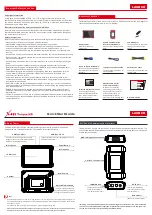
Technical Information
Page 1 of 3
V1. Aug 2018
Sentinel JetFlush Test Kit
For identifying problem areas in systems older than 6 months
Test Kit Components
•
Sentinel X100 Test Kit
•
Turbidity Tube
•
TDS Meter
•
Mini IR Thermometer
•
Conductivity/TDS Standard (1413
µ
S/989ppm)
Introduction
The JetFlush Test Kit is designed for use in conjunction with the Sentinel JetFlush Rapid® domestic central heating
system flushing unit. It will rapidly identify where problems exist due to the build up of corrosion and scale debris
and allow you to demonstrate the effectiveness of the flush once it has been completed. The Survey Report can be
printed and it allows you to record relevant information, both pre and post flushing, to show the improvements to
the system. The completed report can then be left with the customer.
Procedure
Mains Water
Take a sample of cold mains water and measure the TDS using the meter supplied and following the instructions
below. Record the reading in the appropriate box on the Survey Report.
Heating system - Pre-flushing
After setting the boiler thermostat to a temperature below 40°C, as per the JetFlush Rapid® Manual, and allowing
the system to stabilise, a survey of the system should be carried out as follows using the Survey Report:
1.
Locate each radiator and record the locations on the Survey Report.
2.
Measure the temperature at 5 points on each radiator surface by pointing the IR thermometer at the following
points:
•
Bottom left (BL)
•
Top left (TL)
•
Centre (C)
•
Bottom right (BR)
•
Top right (TR)
Record the readings on the Survey Report and note those radiators with substantial cold spots.
3.
Record the settings of any TRVs before opening them to their maximum.
4.
Locate the system drain valve and allow to run to waste for 1 minute taking appropriate care to avoid burns by
using heat resistant gloves. Take a sample of water and carry out the following:
•
Fill the Turbidity Tube to the top mark (200ppm) and look through the column of water. If the black
concentric circles can be seen then record the turbidity as <200ppm.
•
If the circles cannot be seen, remove small volumes of water until they are visible. At the final water
level take the reading off the side of the tube and record on the Survey Report.





















